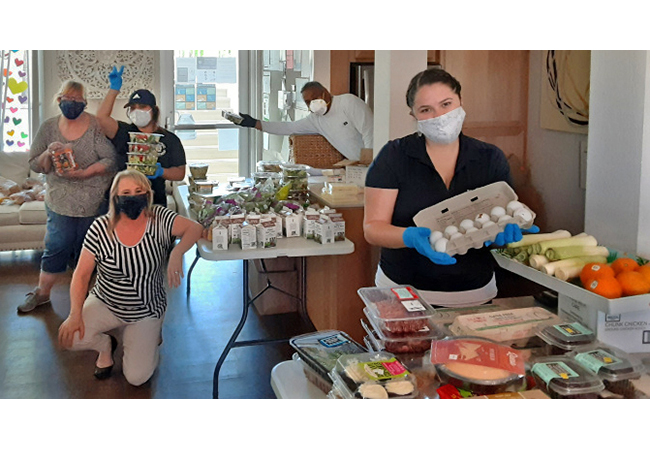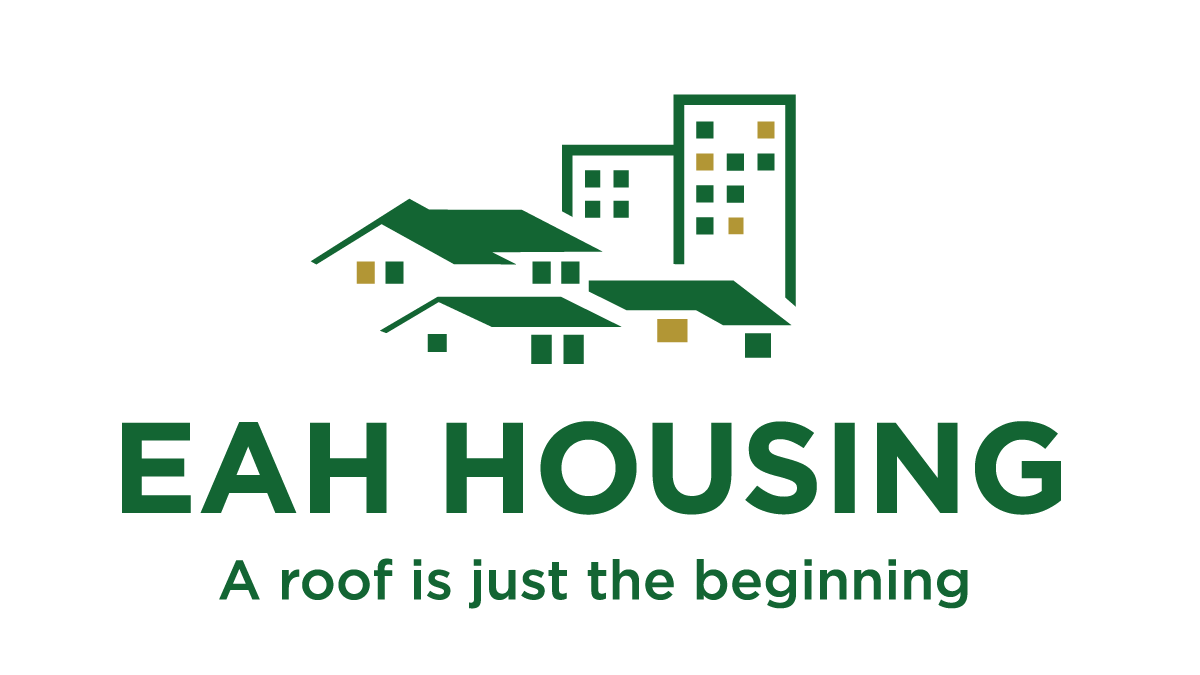
Food for low-income seniors and families — from on-site grocery pantries and senior brown bag lunches to partnerships with community gardens, markets and food banks — has always been a cornerstone of EAH Housing resident services. But as the coronavirus pandemic forces thousands of EAH residents to shelter in place, including workers laid off or told to stay home, those cornerstone connections have become grocery lifelines.
[cycloneslider id=”pantries-and-partners”]
EAH Housing resident services staff have risen to the challenge, bolstering and increasing food delivery to residents and community members. Supported by committed volunteers across California and Hawaiʻi — including residents, community members and staff — EAH has dramatically increased the number of its pantry sites and now distributes twice as much food as before the pandemic.
As the coronavirus crisis has grown, so has the need for food among EAH Housing residents. Those regularly receiving food access information or groceries has jumped from 45 to 85 percent of all 25,000 EAH residents.
“Providing food is lifesaving for some residents, including children, families, seniors, people with disabilities, veterans and the formerly homeless,” says Kristin Taylor, director of resident services for EAH Housing. “For all residents — whether food insecure, or not able to safely get to the store —getting food and access to food resource information in their EAH Housing community is now a critical need.”
Beyond assistance with home schooling, health care options and how to apply for unemployment benefits, residents have a critical need for help getting food. At some properties, Kristin says three of four households are in “deep need” of food bank groceries. “It’s also their only social interaction for the whole week,” she says, “someone knocking on their door and delivering groceries.”
One Northern California resource coordinator, Trisha, makes five trips a month to Second Harvest of Silicon Valley to fill that need. There she stocks up on groceries to distribute at EAH Housing sites she serves in Santa Clara County. Trisha says that thanks to volunteer helpers like Patricia, a resident and retired medical device company receptionist, food gets to everyone.
“Resource coordinators see to it that when they go to the food bank, we get good healthy food,” says Patricia, 71, a resident who helps prebag and hand out groceries at Gateway Santa Clara’s twice-monthly pantries. “I know what it is to not have any food; you appreciate whatever you have, and you look out for others.”
Patricia adds, “I’m a people person. And I like to be involved in helping others. I’m so grateful for the opportunity to help; I love it.”
In Hawaiʻi, EAH Housing staff members on Oahu team up to get food to EAH residents. “We discuss how we can collaborate with each other more as we go forward,” says Helen, resource coordinator at Kukui Gardens. “We try to support each other as best we can.”
Because the food pick-up and distribution process can take six or more hours per site, volunteers are crucial to getting groceries from food banks to residents.
In California, Bertha, a resident volunteer and Virginio, an EAH maintenance employee, assist by driving groceries from a food bank back to their site. There they help prebag and distribute food to residents. In Honolulu, YMCA volunteers hand deliver food bank groceries to dozens of elderly residents living at Kukui Tower.
Other EAH Housing food partners include food rescue organizations, large-scale farms, churches and grocery stores. Every EAH region and site develops a unique set of relationships for getting no-cost food to residents. Some of the organizations collaborating with EAH Housing include:
- White Pony Express, a food rescuer in Contra Costa County, gathers and distributes “high-quality, largely perishable, surplus food from local grocers, retailers, farmers markets, restaurants, catering companies, test kitchens and wholesalers.”
- Palama Settlement on Oahu makes monthly grocery deliveries to those needing food.
- West Hills Community Church and a Trader Joe’s store, both in Santa Clara County, collaborate on a “Neighborhood Shares” food distribution program.
- Pacific Gateway Center, a Hawaiʻi-wide food rescuer, whose current suppliers include Aloun Farms, a large local produce grower and distributor, helps people across the state.
- In the San Jose, Calif. area, Opening Doors, and Loaves and Fishes bring prepared meals to those needing help.
- The Los Angeles Regional Food Bank helps feed people across the area, including EAH Housing residents in North Hollywood, Los Angeles, Mt. Washington and Eagle Rock.
- Community markets across California, including in Fresno County, offer food bank groceries to all needing help.
- In Kauaʻi, county employees helped EAH Housing staff prepare and serve lunches to EAH residents.
- Peninsula Food Runners distributes pre-packaged meals and groceries across San Mateo and Santa Clara counties.
- ExtraFood, a nonprofit food rescuer in Marin county, delivers to those in need throughout the county.
Food banks and our other food partners do their best, but the need is greater than the supply. As Kristin puts it: “If we had an endless supply of food we could triple the amount we distribute.”
The need for volunteers is also greater than the supply. Traditionally, many are older adults, a high-risk group, and many may have stopped volunteering to avoid coronavirus exposure. But some EAH Housing staff members are helping bridge the gap, volunteering time beyond their regular work hours.
This desire to help others energizes EAH Housing resident services staff members. “It’s not just a job,” says Tasha, resource coordinator at Ola Ka Ilima Artspace Lofts in Honolulu. “We dig, we research, we’re always thinking, ‘How can I get residents relief from what they’re going through.’ When we succeed, it’s very gratifying.”

